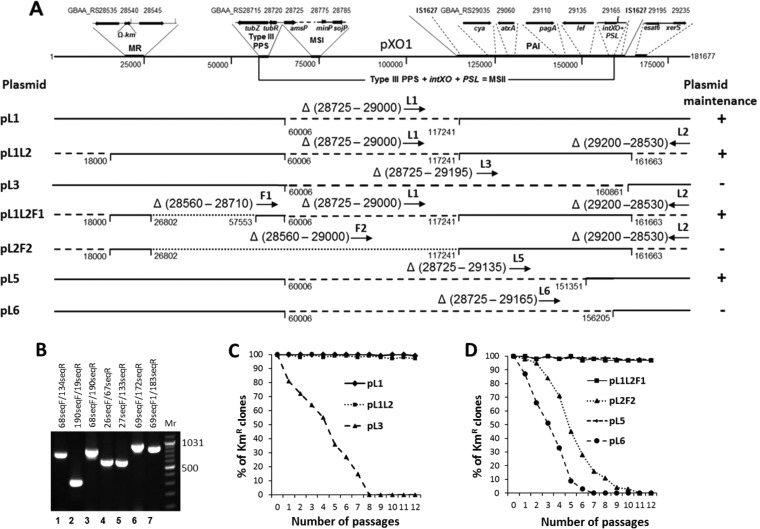FIG 1.
Effects of large deletions within pXO1 on plasmid stability. (A) pXO1 structure, with the minireplicon (MR), type III plasmid partitioning system (type III PPS), first pXO1 maintenance system (MSI), newly discovered second pXO1 maintenance system (MSII), and pathogenicity island (PAI) indicated. The MR structure was adapted from reference 1 and shown with the Ω Kmr cassette inserted into pXO1 GBAA_RS28540 to produce pXO1K (2). The type III PPS structure is based on data from reference 36 and does not include the tubY gene, which was characterized as an essential part of the MSI (amsP) (2). The MSII system, identified in this study, includes the type III PPS combined with the IntXO tyrosine recombinase gene and the recombinase target PSL. The PAI structure, with the IS1627 insertion sequence and B. anthracis toxin components indicated, as well as all other genes indicated on the pXO1 scheme, were prepared according to the Ames Ancestor plasmid pXO1 complete sequence (NCBI GenBank accession no. NC_007322.2). The numbers located below and on both sides of pXO1 represent nucleotide numbers in the complete sequence. The GBAA_RS symbols at the top of the pXO1 diagram are locus tag numbers for the Ames Ancestor plasmid pXO1. The pXO1 regions deleted in each construct are shown in parentheses following the Greek letter Δ (the numbers are for the ORFs in the deleted area). The orientations of loxP (deletions produced with the Cre-loxP system are indicated with dashed lines) and FRT (deletions produced with the Flp-FRT system are indicated with dotted lines) sites that replaced the deleted regions are indicated by arrows and L and F designations, respectively. The numbers located below the deletions are the first and last base pairs included in the deletions. (B) PCR verification of deletions. Primers used to verify the retention of specific segments are indicated at the top of the gel. Lanes: 1, Ames 35K(pL1); 2, Ames 35K(pL2); 3, Ames 35K (pL3); 4, Ames 35K(pL1L2F1); 5, Ames 35K(pL2F2); 6, Ames 35K(pL5); 7, Ames 35K(pL6); Mr, GeneRuler DNA ladder mix for size determination (e.g., 1,031 bp). (C) Percentages of kanamycin-resistant (i.e., plasmid-containing) bacteria in cultures of B. anthracis Ames 35 containing the pXO1K variants with deletions identifying the PAI role in pXO1 maintenance. Bacteria were subcultured every 12 h on LB agar without kanamycin and grown at 37°C. Bacteria from each subculture were diluted and plated on LB agar, with and without kanamycin (20 μg/ml), to determine the fractions retaining the plasmids. Maximum root mean square deviations in the percentage of kanamycin-resistant colonies did not exceed 10%. (D) Percentages of kanamycin-resistant (i.e., plasmid-containing) bacteria in cultures of B. anthracis Ames 35 containing the pXO1K variants with deletions identifying the type III PPS and IntXO involvement in pXO1 maintenance. Maximum root mean square deviations in the percentage of kanamycin-resistant colonies did not exceed 10%.

